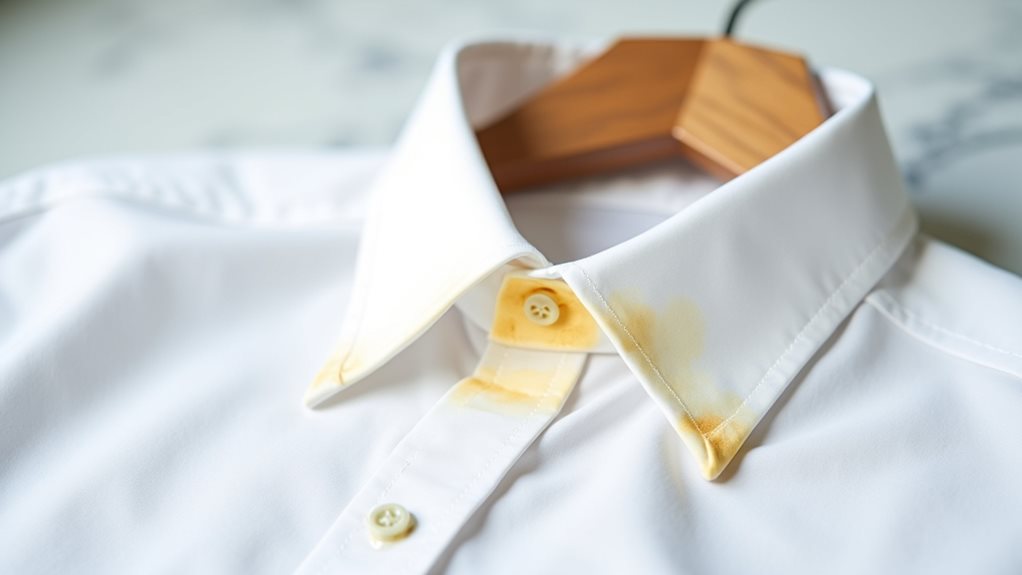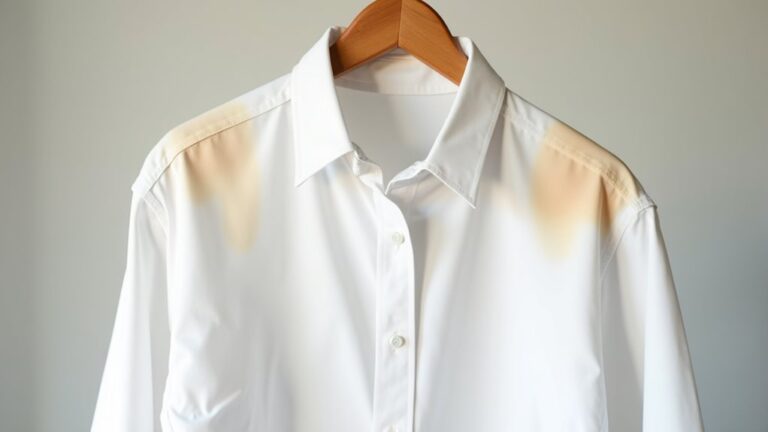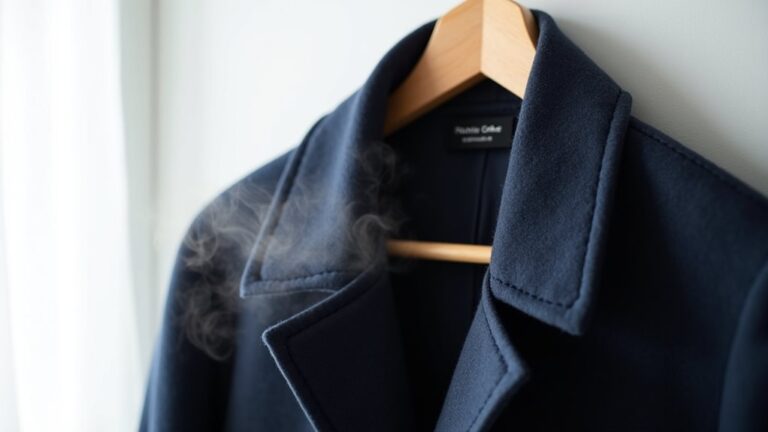Yes, dry cleaning can remove sweat stains, but it’s not always a guaranteed fix – I learned this the hard way with my favorite silk blouse that looked like a science experiment gone wrong. Professional cleaners use specialized solvents and enzyme pre-treatments that break down the proteins and salts in sweat, which work much better than regular detergents on delicate fabrics like wool and silk. However, those stubborn yellow rings from aluminum-based antiperspirants can be trickier, especially if they’ve set in over time, and success really depends on your cleaner’s expertise and the stain’s age. Keep exploring to discover the best approach for your specific situation.
Understanding Sweat Stains and Their Composition
The mystery of those stubborn yellow rings under your favorite shirt’s arms isn’t really a mystery at all—it’s pure chemistry in action, and understanding what you’re dealing with can save you from accidentally making the problem worse.
Your sweat stains aren’t just perspiration; they’re a complex composition of water, salts, proteins, and urea that creates a perfect storm when mixed with deodorants.
That yellowish discoloration you’re seeing? It’s actually a chemical reaction between your natural apocrine sweat and aluminum-based antiperspirants.
Different fabric types react differently to these protein-based stains, which is why some cleaning methods work better than others.
Knowing this helps you choose enzyme-based solutions that actually break down the proteins instead of just pushing them around. 😅
While dry cleaning excels at removing oil-based stains and grease, it has limitations with water-based stains like sweat since the chemical solvents used don’t effectively break down these protein compositions.
How Dry Cleaning Process Works on Sweat Stains
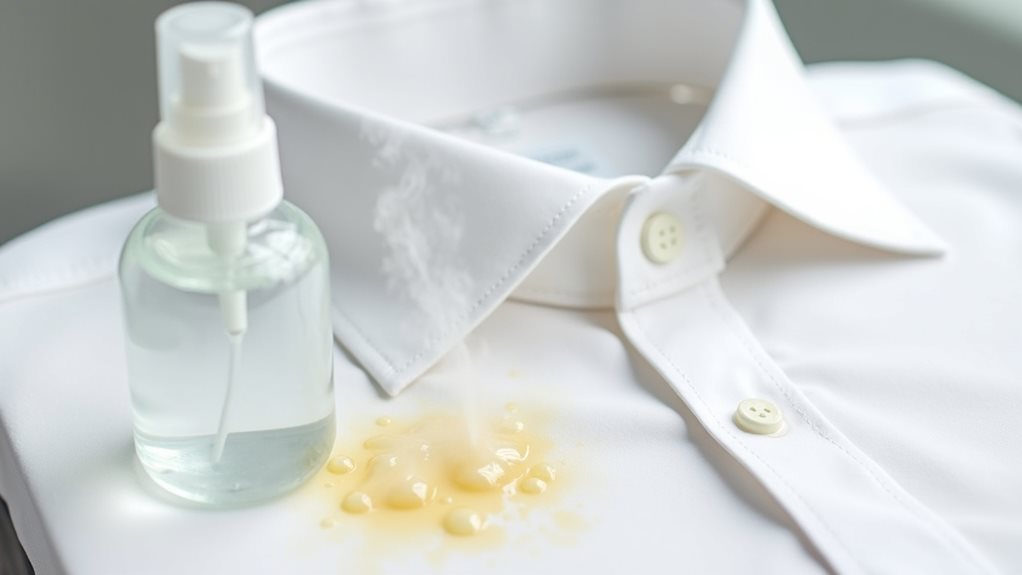
Envision this scenario: you’ve dropped off your favorite silk blouse with those telltale yellow armpit stains at the dry cleaner, and you’re wondering if that $15 investment will actually pay off—spoiler alert, it often does, but the magic happens through a completely different process than what your washing machine does at home.
Professional dry cleaners use specialized cleaning solvents instead of water, which brilliantly tackle oil-based residues that regular detergent can’t touch.
Professional dry cleaners deploy specialized solvents that effortlessly dissolve stubborn oil-based stains that traditional water-based detergents simply cannot penetrate.
Here’s where it gets interesting: they’re also pre-treating stains with enzyme solutions that break down protein components in your sweat, fundamentally dissolving the molecular bonds that make those stains set.
This dry cleaning process protects delicate fabrics while delivering superior stain removal results. 🧥
However, the success of removing sweat stains depends on several factors including how long the stain has been present and whether any previous cleaning attempts may have set it permanently.
Effectiveness of Professional Dry Cleaning for Different Fabric Types
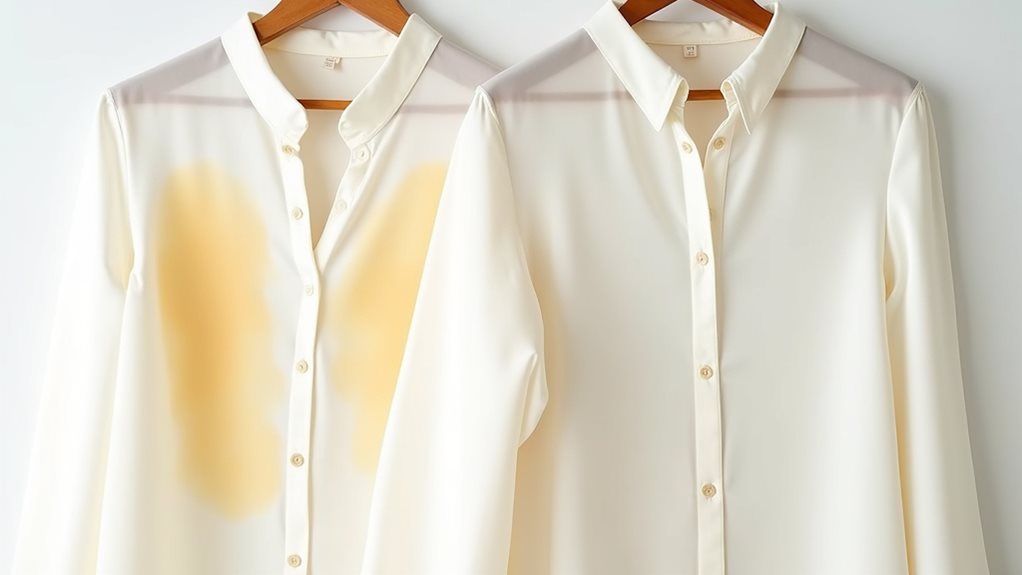
When I first started paying attention to fabric care labels, I’ll admit I was completely baffled by why my cotton t-shirts came out looking fresh while my wool sweater emerged from the same dry cleaning process looking absolutely transformed—and that’s when I learned that different fabrics respond remarkably differently to professional cleaning methods.
You’ll find that delicate fabrics like silk and wool absolutely thrive under professional dry cleaning, where specialized solvents can remove sweat stains without the harsh agitation of home washing.
The success rates for oil-based stain removal jump considerably when you combine proper pre-treatment with the right cleaning process, especially on those “dry clean only” garments that would otherwise suffer permanent damage from DIY attempts.
Professional dry cleaners also use chemical solvents instead of water, which prevents shrinkage and color bleeding while maintaining the structural integrity of your garments.
Limitations and Challenges in Removing Set-In Sweat Stains
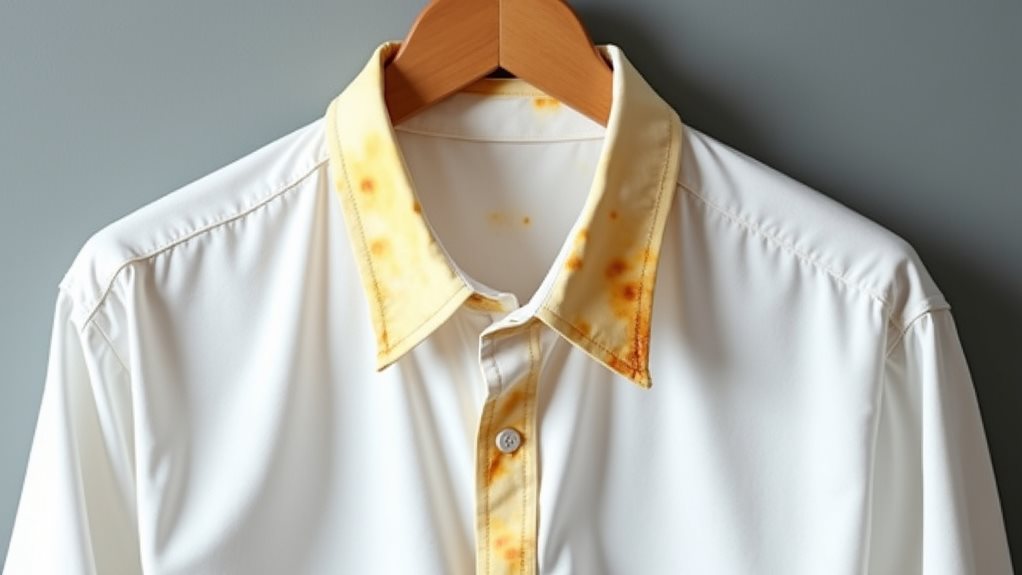
Although professional dry cleaning works wonders on fresh sweat stains, I learned the hard way that once those pesky marks have settled into your favorite shirt for weeks or months, you’re dealing with an entirely different beast altogether.
Set-in sweat stains bond stubbornly with fabric fibers, creating challenges that even skilled dry cleaners struggle to overcome. The protein-based components require specialized enzyme solutions that not every cleaning service offers, and without proper pre-treatment, your results might disappoint you.
I’ve watched dry cleaning lighten discolorations rather than eliminate them completely, especially on delicate fabrics prone to permanent staining.
The harsh reality? Some garments simply can’t be saved once those yellow marks have claimed their territory 😅.
The yellow discoloration becomes particularly problematic because it forms when aluminum in antiperspirants reacts with proteins in sweat, creating compounds that resist the chemical solvents used in traditional dry cleaning processes.
Alternative Home Remedies for Sweat Stain Removal
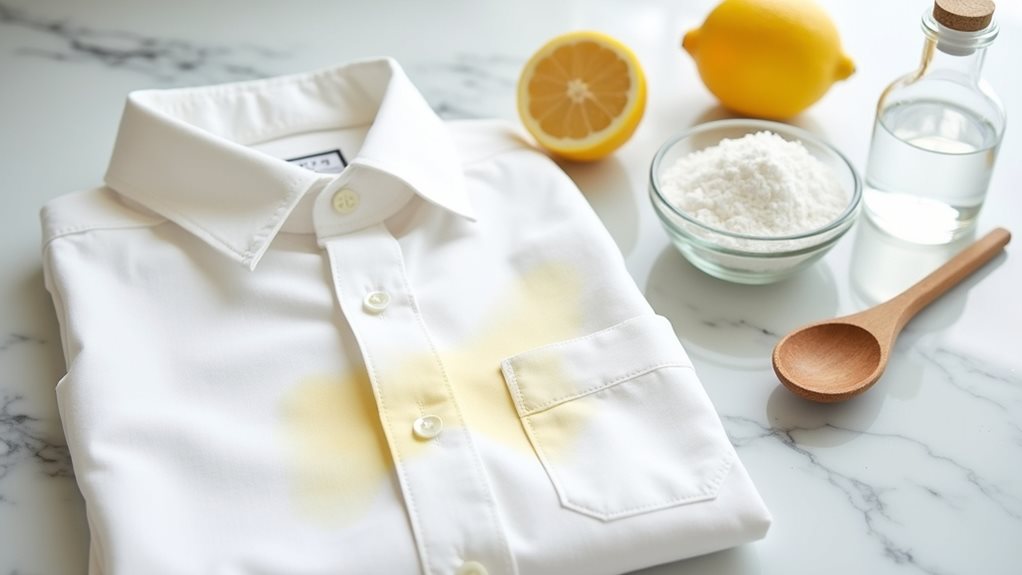
Before you resign yourself to expensive dry cleaning bills, you’ll want to explore some surprisingly effective home remedies that use ingredients already sitting in your kitchen cabinet, like baking soda and white vinegar.
I’ve learned through countless laundry mishaps (including a particularly stubborn yellow stain on my favorite white shirt 😅) that natural solutions often outperform harsh chemicals when it comes to breaking down the protein and salt buildup in sweat stains.
The key lies in understanding proper pre-treatment application methods, which can transform these simple household items into powerful stain-fighting allies that work gently yet effectively on your clothes.
While these home remedies work well for most fabrics, remember that delicate fabrics like silk and wool may require the specialized care that only professional dry cleaning can provide.
Natural Ingredient Solutions
Since my college days of frantically scrubbing yellow armpit stains with whatever I could find in my tiny dorm kitchenette, I’ve discovered that some of the most effective sweat stain fighters aren’t hiding in expensive bottles at the store—they’re probably sitting right in your pantry.
You can create a powerful cleaning solution by mixing baking soda and water into a paste, letting it work its magic for thirty minutes before washing. White vinegar diluted with water tackles stubborn residues, while lemon juice acts as nature’s bleaching agent for delicate fabrics.
Hydrogen peroxide combined with baking soda creates an impressive stain removal powerhouse. These natural remedies don’t just eliminate existing marks—they’ll help prevent sweat stains from becoming permanent fixtures on your favorite shirts.
For garments made from delicate materials like silk or wool that can’t handle these home treatments, professional dry cleaning services use specialized solvents that can effectively break down protein-based stains without damaging the fabric.
Pre-Treatment Application Methods
Knowing which natural ingredients work best is only half the battle—the real game-changer lies in how you actually apply these remedies to maximize their stain-busting potential.
Unlike dry cleaning solvents that work through chemical processes, pre-treating armpit stains at home requires patience and proper technique. When using baking soda paste, I’ve learned that rubbing it gently into fabric fibers, then letting it sit for at least 30 minutes, dramatically improves results compared to quick applications.
For vinegar solutions, soaking the entire stained area guarantees deeper penetration than surface dabbing. Commercial stain removers work best when applied directly and allowed to penetrate before washing.
While home remedies can be effective for fresh stains, protein-based stains like sweat often respond better to professional dry cleaning solvents that can dissolve what water-based treatments cannot penetrate.
Prevention Strategies to Avoid Sweat Stains
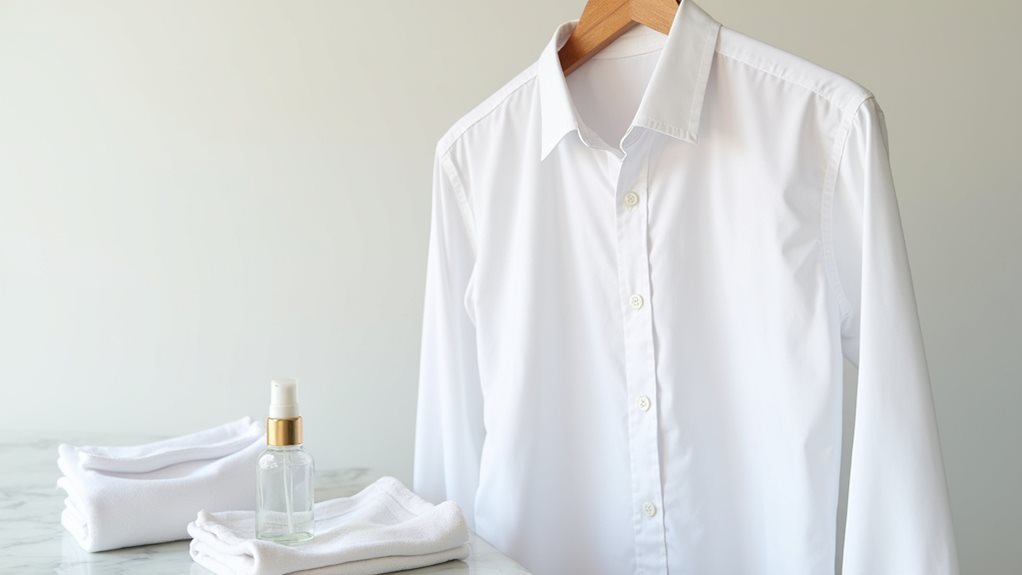
While you can’t always control when your body decides to turn up the heat, you can absolutely take charge of preventing those stubborn sweat stains that seem to haunt our favorite shirts like unwelcome houseguests.
Start by choosing breathable fabrics like cotton or moisture-wicking materials that’ll reduce sweat accumulation instead of trapping it against your skin. Loose-fitting garments create better airflow around those trouble zones, while aluminum-free deodorants won’t react with your sweat to create those dreaded yellow marks.
Regular grooming of underarm hair helps minimize sweat retention, and honestly, it’s a game-changer for keeping your clothing fresher longer.
When sweat stains do occur, consider that traditional dry cleaning uses perchloroethylene (PERC), a chemical solvent that can leave residues on garments, so always allow dry cleaned items to air out before wearing them close to your skin.
These simple prevention strategies will help you prevent armpit stains before they become your laundry nemesis!
When to Choose Professional Services Vs Home Treatment
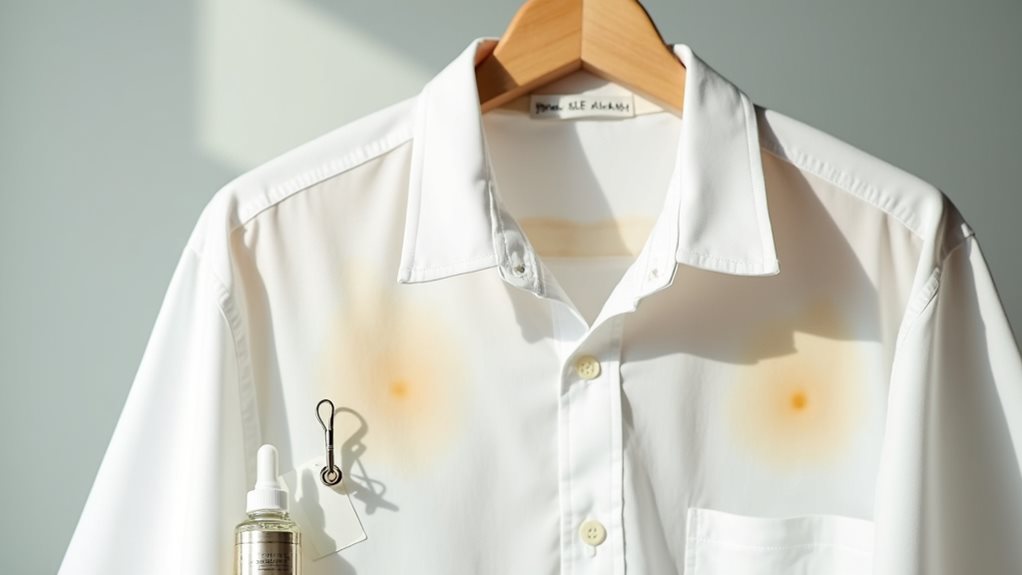
You’re probably staring at that yellowed underarm area wondering if you should tackle it yourself or surrender your favorite shirt to the professionals, and honestly, I’ve been there more times than I’d like to admit 😅.
The decision really comes down to three key factors: how stubborn and set-in those stains actually are, what type of fabric you’re dealing with (because trust me, silk requires a completely different approach than cotton), and whether you’re willing to invest the time and money for the best possible outcome.
I learned the hard way that my grandmother’s vintage blouse needed professional care when my enthusiastic home treatment turned a small sweat mark into a fabric disaster, so now I always weigh these considerations before making my move.
Professional dry cleaning uses chemical solvents instead of water, making it particularly effective at removing protein-based stains like sweat that can be challenging for traditional home washing methods.
Stain Severity Assessment
Nobody wants to admit they’ve let a perfectly good shirt become a casualty of procrastination, but here’s the truth—I’ve stared at yellowed underarm stains wondering if my favorite button-down was destined for the donation pile 😅.
When conducting your stain severity assessment, you’ll need to evaluate whether those protein stains require professional dry cleaning services or if home remedies might still work their magic. Fresh sweat stains often respond well to baking soda treatments, but stubborn stains that have set in typically demand professional intervention.
Consider your fabric type too—delicate fabrics can’t handle aggressive home cleaning attempts without compromising garment integrity.
If you’ve already tried multiple approaches to cleaning remove armpit stains without success, it’s time to call in the professionals. Since protein-based stains like sweat typically respond better to water-based treatments rather than chemical solvents, be sure to discuss treatment options with your dry cleaner.
Fabric Type Considerations
When I learned the hard way that my grandmother’s vintage silk blouse couldn’t handle my enthusiastic vinegar-and-baking-soda treatment, I discovered that fabric type fundamentally acts as your roadmap for choosing between professional dry cleaning and DIY solutions 🤦♀️.
Delicate fabrics like silk and wool desperately need professional cleaners who understand their fragile nature, while cotton and polyester can typically handle your home treatments without throwing a tantrum.
If you see “dry clean only” on that care label, trust it—those manufacturers aren’t just trying to make your life complicated.
For stubborn sweat stains on precious garments, professional stain treatments preserve garment condition far better than aggressive DIY experiments that might leave you mourning your favorite pieces.
Time and Cost
Beyond fabric considerations, the reality of your wallet and schedule often becomes the deciding factor between rolling up your sleeves for a DIY rescue mission or surrendering that stained garment to professional hands.
Professional dry cleaning typically costs $8-15 per garment, but when you’re dealing with stubborn sweat stains on delicate fabrics or high-value garments, that investment often beats replacing a ruined favorite 😅.
While home remedies might work for fresh stains, specialized solvents used in professional stain removal tackle protein-based sweat marks more effectively.
Time-wise, dry cleaners usually offer 24-48 hour turnaround, which honestly beats my weekend warrior attempts that sometimes stretch into multi-day experiments with questionable results.

